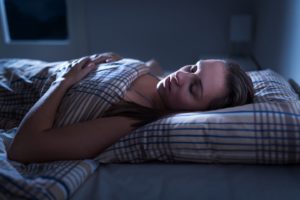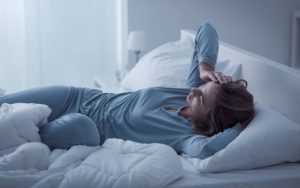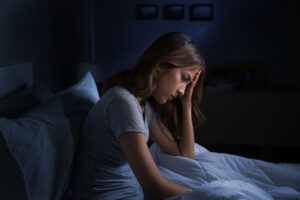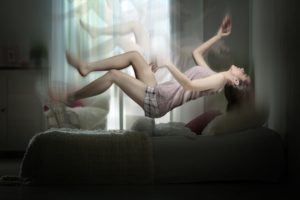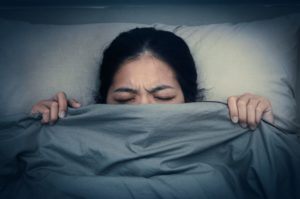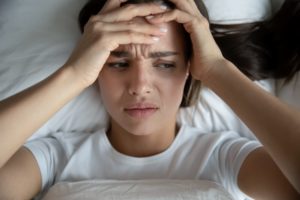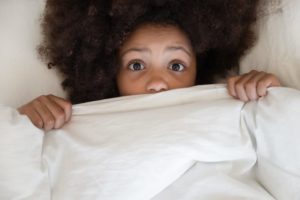Sexsomnia: What to Know About Sleep Sex
- Sexsomnia is a sleep disorder characterized by engaging in sexual activities during sleep.
- The causes of sexsomnia are not entirely clear but may be related to other sleep disorders and external factors like stress and alcohol.
- A sleep study may help to diagnose sexsomnia, or identify another sleep disorder or medical condition associated with sexsomnia.
- Treatment for sexsomnia depends on the underlying cause, but often includes medication, improving sleep hygiene, and reducing stress or triggers.
Sexsomnia, also known as sleep sex, is a type of sleep disorder known as a parasomnia. Parasomnias refer to unusual sensations and behaviors, such as sleepwalking, that people may experience or exhibit while asleep, falling asleep, or waking up. In the case of sexsomnia, people engage in sexual behaviors such as masturbation, sexual movements, sexual aggression, or initiating sex with another person. Though their eyes may be open and they may make sexual noises, they are asleep during these activities and unaware of their behavior once they are awake.
It is difficult for experts to estimate how many people experience sexsomnia. The disorder can occur unexpectedly, and a person may not know they experience it unless another person notices the effects. However, nearly 8% of people at a sleep center exhibited symptoms of the disorder.
Sexsomnia can cause considerable shame and distress for both people who experience it and their partners. However, treatment is possible and may include the use of medications or lifestyle changes, depending on the underlying cause of the parasomnia.
Is Your Sexsomnia a Concern?
Sexsomnia and other sleep disruptions are often indicative of other issues such as sleep apnea. Answer three questions to understand if you should be concerned.
What Are the Symptoms of Sexsomnia?
The symptoms of sexsomnia vary depending on the person, but the underlying feature of this parasomnia is that a sleeping person exhibits sexual behaviors that they are unaware of and unable to control. These behaviors can include :
- Masturbation
- Fondling
- Sexual noises
- Sexual movements
- Initiating sexual activities
- Sexual aggression
- Sexual assault
Sexsomnia can occur alongside other parasomnias, including sleepwalking and sleep talking. It appears to be more common in men than in women, possibly up to three times more common. Masturbation is the most common behavior in women with sexsomnia.
In addition to the sexual behaviors, signs that someone is acting under the influence of a sexual parasomnia include:
- Unresponsiveness or minimal responsiveness to conversation or the environment
- Unusual sexual responses or aggression
- Inability to be woken, or difficulty being woken
- No memory of their sexual behaviors once awake
- Trauma to the genitals, often due to abrasion
Nocturnal emissions, commonly called “wet dreams,” are not the same thing as sexsomnia. Nocturnal emissions are considered a normal part of male adolescent development and are also experienced by adult men . However, some people with sexsomnia may mistake their condition for nocturnal emissions if their behavior is not witnessed by another person.
What Causes Sexsomnia?
Research into the causes of sexsomnia remains limited, but experts have found that it is associated with a wide range of underlying conditions and risk factors. These include:
- Other parasomnias, such as sleepwalking and REM sleep behavior disorder
- Obstructive sleep apnea
- Sleep-related seizures
- Kleine-Levin syndrome
- Chronic insomnia
- Restless legs syndrome
- Narcolepsy
- Persistent sexual arousal syndrome
- Sleep-related dissociative disorders
- Nocturnal psychotic disorders
- Bruxism , or teeth grinding
What Triggers Sexsomnia?
Not all sexsomnia can be linked to an underlying medical cause. Some cases appear to be brought on by environmental or lifestyle triggers. These triggers may also cause the onset of sexsomnia in people with an underlying disorder. Commonly reported triggers include stress, anxiety, depression, alcohol and substance use, and sleep deprivation. However, sexsomnia triggers also seem to vary from person to person.

How Is Sexsomnia Diagnosed?
Most people who experience symptoms of sexsomnia do not report them to their doctor. Shame is a common factor among people with this disorder, but it is important to remember that sexsomnia is often treatable, and medical professionals have your best interests in mind.
If you are concerned about the possibility that you experience this parasomnia, speaking to a medical professional is the first step in diagnosis and treatment. Your doctor may recommend a recorded sleep study, or video-polysomnography, in order to better understand your condition and any underlying sleep-related causes. This may include an extended electroencephalogram (EEG) to assess for seizures.
How Is Sexsomnia Treated?
Treatment for sexsomnia depends on the underlying cause.
Benzodiazepine (such as clonazepam) is commonly prescribed to treat sexsomnia. Sexsomnia associated with other sleep disorders is usually relieved by treating the underlying problem, such as the use of continuous positive airway pressure (CPAP) machine or a mandibular advancement device for obstructive sleep apnea. Cases of sexsomnia caused by seizures respond well to anticonvulsant therapy.
As sexsomnia appears to be caused by a wide range of conditions, your doctor may prescribe treatment options related to your unique circumstances. They may also suggest that you make lifestyle changes to avoid potential triggers and take steps to ensure your safety and the safety of others in your home until the condition is under control.
Coping With Sexsomnia
Sexsomnia can be highly upsetting for both the person with the disorder and the people in their life. Since people with this parasomnia are unaware of and not in control of their actions while asleep, they may behave in ways they would never choose to while awake. This can pose serious, distressing complications around consent, as sexsomnia may cause someone to be sexually aggressive or initiate sex with a person they would otherwise not behave sexually with.
Receiving a diagnosis and appropriate treatment is the first step in coping with sexsomnia. While many people feel shame around their condition, speaking openly and honestly with the people in their life about diagnosis and treatment helps keep everyone safe. Counseling, both for the person with sexsomnia and any others who are affected, can help with the emotional toll this disorder can pose.
As sexsomnia treatment may not be immediately effective, it is crucial to take safety precautions as necessary. Depending on your situation, this may involve:
- Sleeping in a separate room
- Avoiding sleeping around strangers or minors
- Locking bedroom doors
- Avoiding all known or possible triggers
- Setting movement alarms, particularly in cases of associated sleepwalking
It is crucial to have good sleep hygiene, which has been shown to help people with parasomnias. Following a sleep schedule, winding down at the end of the day, and keeping a consistent bedtime routine are all part of healthy sleep hygiene.

Still have questions? Ask our community!
Join our Sleep Care Community — a trusted hub of sleep health professionals, product specialists, and people just like you. Whether you need expert sleep advice for your insomnia or you’re searching for the perfect mattress, we’ve got you covered. Get personalized guidance from the experts who know sleep best.
References
10 Sources
-
Singh, S., Kaur, H., Singh, S., & Khawaja, I. (2018). Parasomnias: A Comprehensive Review. Cureus, 10(12), e3807.
https://pubmed.ncbi.nlm.nih.gov/30868021/ -
McCann, K. (2010, May 12). Study finds that sexsomnia is common in sleep center patients. American Academy of Sleep Medicine., Retrieved July 28, 2021, from
https://aasm.org/study-finds-that-sexsomnia-is-common-in-sleep-center-patients/ -
Schenck, C. H., Arnulf, I., & Mahowald, M. W. (2007). Sleep and sex: What can go wrong? A review of the literature on sleep related disorders and abnormal sexual behaviors and experiences. Sleep, 30(6), 683–702.
https://pubmed.ncbi.nlm.nih.gov/17580590/ -
Trajanovic, N. N., Mangan, M., & Shapiro, C. M. (2007). Sexual behaviour in sleep: An internet survey. Social Psychiatry and Psychiatric Epidemiology, 42(12), 1024–1031.
https://pubmed.ncbi.nlm.nih.gov/17932612/ -
Dubessy, A.-L., Leu-Semenescu, S., Attali, V., Maranci, J.-B., & Arnulf, I. (2017). Sexsomnia: A specialized non-rem parasomnia? Sleep, 40(2).
https://pubmed.ncbi.nlm.nih.gov/28364495/ -
Gul, A., Yuruk, E., & Serefoglu, E. C. (2020). Frequency of nocturnal emissions and masturbation habits among virgin male religious teenagers. Revista Internacional De Andrologia, 18(1), 21–26.
https://pubmed.ncbi.nlm.nih.gov/30606622/ -
Meng, X., Fan, L., Liu, J., Wang, T., Yang, J., Wang, J., Wang, S., & Ye, Z. (2013). Fresh semen quality in ejaculates produced by nocturnal emission in men with idiopathic anejaculation. Fertility and Sterility, 100(5), 1248–1252.
https://pubmed.ncbi.nlm.nih.gov/23987518/ -
Wieckiewicz, M., & Winocur, E. (2020). Special issue: Sleep bruxism-The controversial sleep movement activity. Journal of Clinical Medicine, 9(3), 880.
https://pubmed.ncbi.nlm.nih.gov/32210201/ -
Khawaja, I. S., Hurwitz, T. D., & Schenck, C. H. (2017). Sleep-related abnormal sexual behaviors (sexsomnia) successfully treated with a mandibular advancement device: A case report. Journal of Clinical Sleep Medicine: JCSM: Official Publication of the American Academy of Sleep Medicine, 13(4), 627–628.
https://pubmed.ncbi.nlm.nih.gov/28095975/ -
Drakatos, P., Marples, L., Muza, R., Higgins, S., Gildeh, N., Macavei, R., Dongol, E. M., Nesbitt, A., Rosenzweig, I., Lyons, E., d’Ancona, G., Steier, J., Williams, A. J., Kent, B. D., & Leschziner, G. (2019). NREM parasomnias: A treatment approach based upon a retrospective case series of 512 patients. Sleep Medicine, 53, 181–188.
https://pubmed.ncbi.nlm.nih.gov/29753639/



